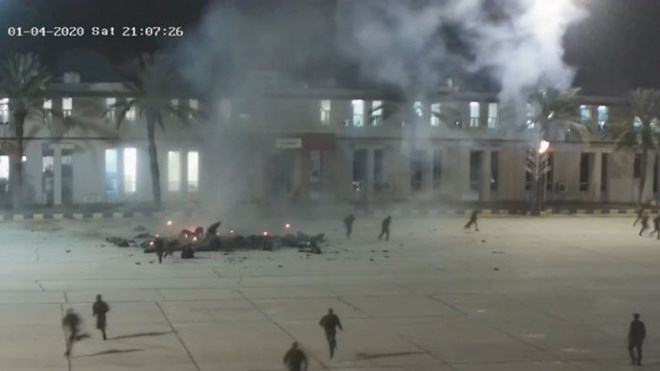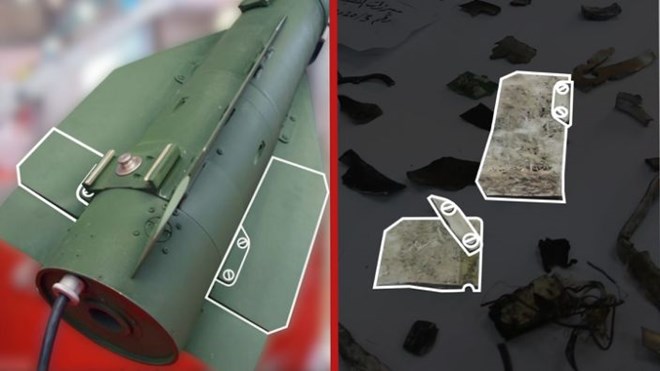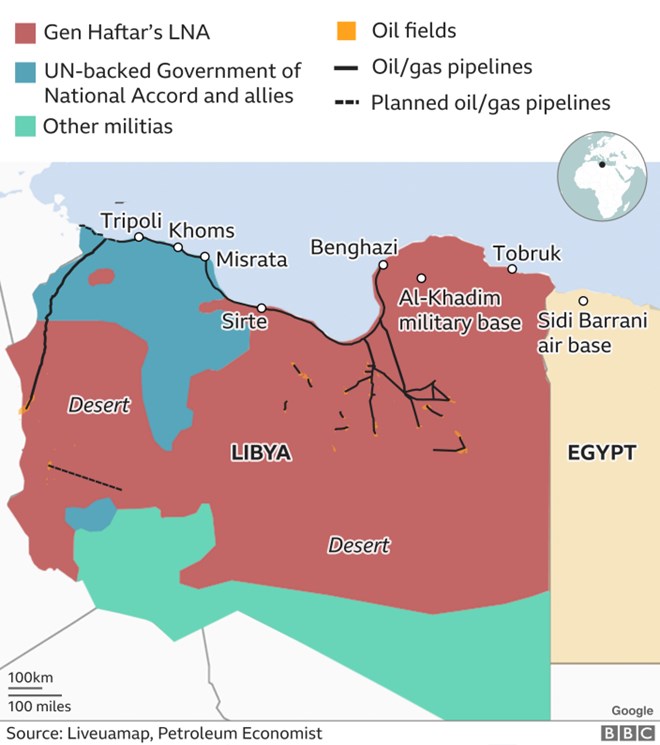
Friday August 28, 2020

The cadets were doing military drills when the drone struck
The BBC has uncovered new evidence that a drone operated by the United Arab Emirates killed 26 unarmed cadets at a military academy in Libya's capital Tripoli in January 2020.
At the time of the strike on 4 January, Tripoli was under siege by the self-styled Libyan National Army (LNA).
It has denied responsibility for the attack and suggested the cadets had been killed by local shelling.
But evidence indicates the cadets were hit by a Chinese Blue Arrow 7 missile.
This was fired by a drone called the Wing Loong II and the investigation by BBC Africa Eye and BBC Arabic Documentaries also found evidence that, at the time of the strike, Wing Loong II drones were only operating from one Libyan air base - Al Khadim - and that the UAE supplied and operated the drones that were stationed there.The UAE has previously denied military involvement in Libya and says it supports the UN peace process. It did not respond to the BBC's request for comment.
What happened to these cadets?
Just after 21:00 on 4 January 2020, around 50 cadets were doing routine drills at a military academy in the south of Tripoli.
Without warning, an explosion detonated in the centre of the group, leaving 26 cadets dead or dying on the parade ground. Many were still teenagers. None of them were armed.
One of those who survived was 20 year-old Abdul Moeen.
He was inside the academy when the strike hit. "It was indescribable," he told the BBC.
"We were witnessing our colleagues dying, breathing their last breath, and we couldn't do anything... There were guys whose torsos were separated from their bodies. It was an awful crime, a crime that has nothing to do with humanity."
Seven months after the strike, no-one has admitted responsibility for killing these young men.
The LNA, under Gen Khalifa Haftar, denied that it was behind the strike and told the press that the explosion might have been caused by a locally fired mortar shell or an attack from inside the academy.
What did the BBC find?
The investigation found evidence that a much more sophisticated weapon was used.
By looking at images of the shrapnel that was left on the parade ground after the strike, the BBC concluded that it matched the components of a missile called the Blue Arrow 7.

Images of the shrapnel
Our analysis found only one aircraft, operating over Tripoli in January 2020, that was capable of firing this weapon - a drone called the Wing Loong 2.Just three weeks before this strike, the UN also concluded that the Blue Arrow 7 "is ballistically paired to be delivered by the Wing Loong II... and by no other aviation asset identified in Libya to date".
The BBC also looked into where this drone might have come from, and found evidence that, at the time of the attack, Wing Loong drones were only operating from one Libyan air base: al-Khadim, in LNA-controlled eastern Libya.
Both the BBC and the UN have found evidence that drones operating from this air base belong to the United Arab Emirates.
In 2019, the UN found that, by sending Wing Loong drones and Blue Arrow 7 missiles into Libya, the UAE had violated the UN arms embargo on the country, which has been in force since 2011.
The BBC also found an arms registry showing that, in 2017, the UAE bought 15 Wing Loong drones and 350 Blue Arrow 7 missiles.
What else did the BBC uncover?
The BBC investigation also found new evidence that Egypt is allowing the UAE to use Egyptian military air bases close to the Libyan border.
In February 2020, the Wing Loong II drones stationed in Libya appear to have been moved over the border into Egypt, to an air base near Siwa in the western Egyptian desert.

Map of Libya
Satellite imagery also shows that a second Egyptian military air base, Sidi Barrani, has been used as an operating base for Mirage 2000 fighter jets painted in colours that are not used by the Egyptian air force, but which exactly match the jets flown by the UAE.This is the same model of plane implicated by the UN in an air strike on a migrant centre east of Tripoli in July 2019 in which 53 people were killed.
Sidi Barrani is also the destination for multiple cargo planes that took off from the UAE, suggesting an air bridge for equipment or supplies between the UAE and a military base just 80km (50 miles) from the Libyan border.
The Egyptian government did not respond to the BBC's request for comment.
Is foreign military involvement surprising?
Both the UAE and Egypt attended a conference on Libya convened by German Chancellor Angela Merkel in Berlin in January this year, where they reiterated their support for the UN peace process and agreed to refrain from intervention in Libya's war.
But in the past year, there has been an escalation in the use of drones by both sides in the conflict.
Ghassan Salamé, the former head of the UN mission in Libya, described this as "possibly the largest drone war theatre now in the world".
The UAE is not the only foreign power involved in this conflict.
Earlier this year, BBC Africa Eye revealed that Turkey was also in breach of the UN arms embargo on Libya by sending secret shipments of weapons to the UN-recognised government in Tripoli.
With the backing of Turkey, the UN-recognised Government of National Accord has now beaten back Gen Haftar's LNA from the area around Tripoli.